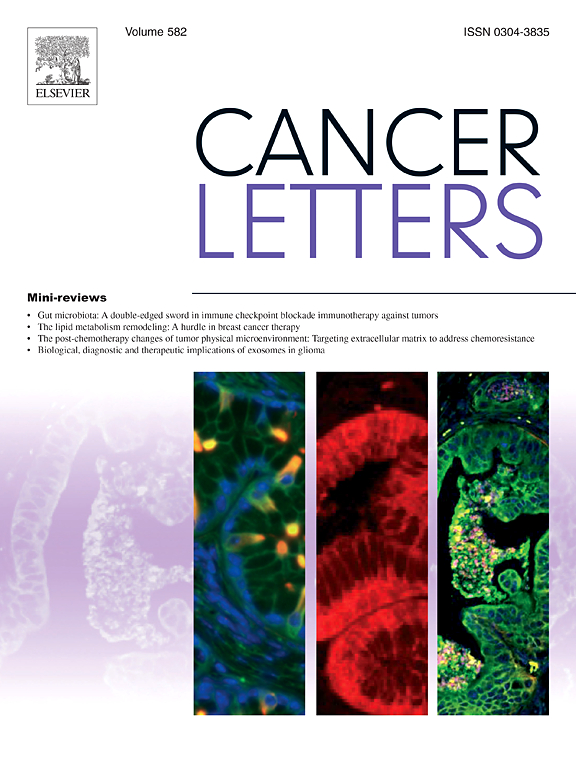异葫芦素B通过靶向小窝蛋白1促进神经胶质瘤的发生抑制胶质瘤。
IF 9.1
1区 医学
Q1 ONCOLOGY
引用次数: 0
摘要
胶质瘤以其侵袭性、高复发率和对常规治疗的耐药性而闻名,需要开发新的治疗策略。本研究强调了CAV1 (CAV1)在胶质瘤进展中的关键作用,并强调了异丘脲素b的有效抗胶质瘤作用,该化合物有效抑制胶质瘤细胞的增殖、侵袭、迁移和上皮-间质转化,同时诱导G2/M期阻滞和促进细胞凋亡。进一步的分析显示异葫芦素B通过下调CAV1来促进anoikis,这是一种由脱离引起的细胞死亡。值得注意的是,异葫芦素B直接与CAV1结合,通过细胞热移实验和微尺度热电泳证实,将CAV1定位为关键的治疗靶点。此外,异葫芦素B激活BKCa钙通道,导致细胞内Ca2+增加和pH降低,在钙动力学和疾病之间建立了新的联系。过表达CAV1可抑制瘤样病变,阻断细胞凋亡,促进迁移,而过表达CAV1可促进瘤样病变,显著降低胶质瘤细胞的增殖和活力。斑马鱼异种移植物和原位胶质母细胞瘤模型的体内实验进一步证明异葫芦素B通过下调CAV1有效抑制肿瘤生长。这些发现强调了异丘脲素B多方面的抗胶质瘤潜力,并强调了CAV1作为胶质瘤治疗的关键介质和有希望的治疗靶点。本文章由计算机程序翻译,如有差异,请以英文原文为准。

Isocucurbitacin B inhibits gliomas through the promotion of anoikis by targeting caveolin 1
Gliomas, known for their aggressive nature, high recurrence rates, and resistance to conventional therapies, require the development of novel treatment strategies. This study emphasizes the critical role of caveolin 1 (CAV1) in glioma progression and highlights the potent anti-glioma effects of isocucurbitacin B. The compound effectively inhibits glioma cell proliferation, invasion, migration, and epithelial-mesenchymal transition, while also inducing G2/M phase arrest and promoting apoptosis. Further analysis revealed that isocucurbitacin B promotes anoikis, a form of cell death induced by detachment, by downregulating CAV1. Notably, isocucurbitacin B directly binds to CAV1, confirmed by cellular thermal shift assays and microscale thermophoresis, positioning CAV1 as a key therapeutic target. Additionally, isocucurbitacin B activates the BKCa calcium channel, resulting in increased intracellular Ca2+ and reduced pH, establishing a novel connection between calcium dynamics and anoikis. Overexpression of CAV1 inhibited anoikis, blocking apoptosis and promoting migration, while decreased CAV1 expression facilitated anoikis and significantly reduced glioma cell proliferation and motility. In vivo experiments using zebrafish patient-derived xenografts and orthotopic glioblastoma models further demonstrated that isocucurbitacin B effectively suppresses tumor growth by downregulating CAV1. These findings underscore the multifaceted anti-glioma potential of isocucurbitacin B and highlight CAV1 as a crucial mediator of anoikis and a promising therapeutic target in glioma treatment.
求助全文
通过发布文献求助,成功后即可免费获取论文全文。
去求助
来源期刊

Cancer letters
医学-肿瘤学
CiteScore
17.70
自引率
2.10%
发文量
427
审稿时长
15 days
期刊介绍:
Cancer Letters is a reputable international journal that serves as a platform for significant and original contributions in cancer research. The journal welcomes both full-length articles and Mini Reviews in the wide-ranging field of basic and translational oncology. Furthermore, it frequently presents Special Issues that shed light on current and topical areas in cancer research.
Cancer Letters is highly interested in various fundamental aspects that can cater to a diverse readership. These areas include the molecular genetics and cell biology of cancer, radiation biology, molecular pathology, hormones and cancer, viral oncology, metastasis, and chemoprevention. The journal actively focuses on experimental therapeutics, particularly the advancement of targeted therapies for personalized cancer medicine, such as metronomic chemotherapy.
By publishing groundbreaking research and promoting advancements in cancer treatments, Cancer Letters aims to actively contribute to the fight against cancer and the improvement of patient outcomes.
 求助内容:
求助内容: 应助结果提醒方式:
应助结果提醒方式:


